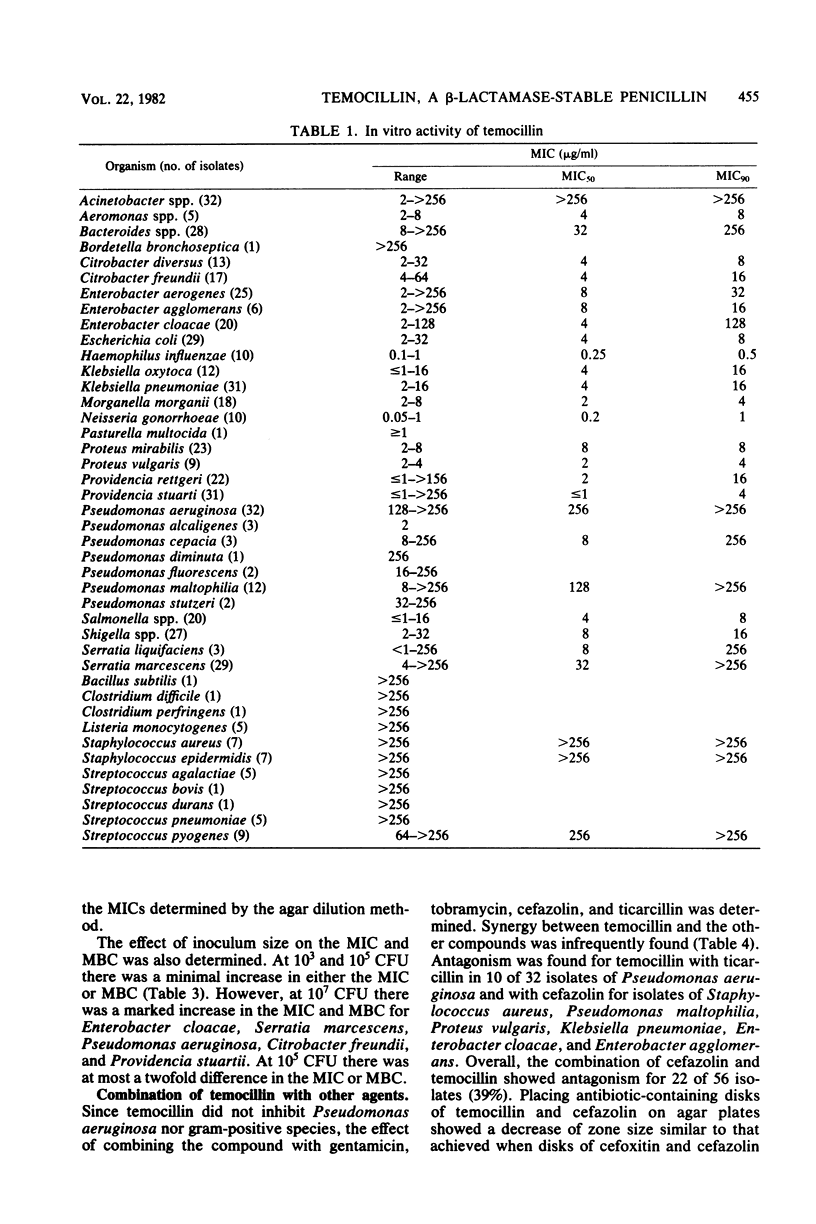Abstract
Temocillin, a 6-alpha-methoxy penicillin, inhibited 90% of strains of Escherichia coli, Klebsiella pneumoniae, Citrobacter, Proteus, Providencia, Salmonella, and Shigella at a concentration of less than or equal to 16 micrograms/ml. Haemophilus influenzae and Neisseria gonorrhoea were inhibited by less than or equal to 1 microgram/ml. Changing the medium or pH of the cultures did not alter the minimal inhibitory concentrations, which were similar in broth and human serum, as were the minimal bactericidal concentrations. An increase in inoculum size from 10(5) to 10(7) colony-forming units increased concentration required for inhibition. Temocillin inhibited strains resistant to ampicillin, ticarcillin, cefazolin, cefamandole, and cefoxitin. Most Pseudomonas aeruginosa strains and other Pseudomonas spp. and Acinetobacter spp. were resistant, as were gram-positive organisms. Temocillin was not hydrolyzed by the common plasmid and chromosomal beta-lactamases but inhibited them. The resistance of certain gram-negative bacilli to temocillin seemed to be a result of failure of the molecule to enter through the cell wall, since combination of temocillin with EDTA made Pseudomonas, Acinetobacter, and Enterobacter strains susceptible to low concentrations of the compound.
Full text
PDF







Selected References
These references are in PubMed. This may not be the complete list of references from this article.
- Acar J. F., Sabath L. D., Ruch P. A. Antagonism of the antibacterial action of some penicillins by other penicillins and cephalosporins. J Clin Invest. 1975 Mar;55(3):446–453. doi: 10.1172/JCI107950. [DOI] [PMC free article] [PubMed] [Google Scholar]
- Cama L. D., Leanza W. J., Beattie T. R., Christensen B. G. Substituted penicillin and cephalosporin derivatives. I. Stereospecific introduction of the C-6(7) methoxy group. J Am Chem Soc. 1972 Feb 23;94(4):1408–1410. doi: 10.1021/ja00759a089. [DOI] [PubMed] [Google Scholar]
- Fu K. P., Neu H. C. The comparative beta-lactamase resistance and inhibitory activity of 1-oxa cephalosporin, cefoxitin and cefotaxime. J Antibiot (Tokyo) 1979 Sep;32(9):909–914. doi: 10.7164/antibiotics.32.909. [DOI] [PubMed] [Google Scholar]
- Georgopapadakou N. H., Liu F. Y. Binding of beta-lactam antibiotics to penicillin-binding proteins of Staphylococcus aureus and Streptococcus faecalis: relation to antibacterial activity. Antimicrob Agents Chemother. 1980 Nov;18(5):834–836. doi: 10.1128/aac.18.5.834. [DOI] [PMC free article] [PubMed] [Google Scholar]
- Matthew M. Plasmid-mediated beta-lactamases of Gram-negative bacteria: properties and distribution. J Antimicrob Chemother. 1979 Jul;5(4):349–358. doi: 10.1093/jac/5.4.349. [DOI] [PubMed] [Google Scholar]
- Neu H. C., Fu K. P. Synergy of azlocillin and mezlocillin combined with aminoglycoside antibiotics and cephalosporins. Antimicrob Agents Chemother. 1978 May;13(5):813–819. doi: 10.1128/aac.13.5.813. [DOI] [PMC free article] [PubMed] [Google Scholar]
- O'Callaghan C. H., Morris A., Kirby S. M., Shingler A. H. Novel method for detection of beta-lactamases by using a chromogenic cephalosporin substrate. Antimicrob Agents Chemother. 1972 Apr;1(4):283–288. doi: 10.1128/aac.1.4.283. [DOI] [PMC free article] [PubMed] [Google Scholar]
- Sanders C. C., Sanders W. E., Jr Emergence of resistance to cefamandole: possible role of cefoxitin-inducible beta-lactamases. Antimicrob Agents Chemother. 1979 Jun;15(6):792–797. doi: 10.1128/aac.15.6.792. [DOI] [PMC free article] [PubMed] [Google Scholar]
- Slocombe B., Basker M. J., Bentley P. H., Clayton J. P., Cole M., Comber K. R., Dixon R. A., Edmondson R. A., Jackson D., Merrikin D. J. BRL 17421, a novel beta-lactam antibiotic, highly resistant to beta-lactamases, giving high and prolonged serum levels in humans. Antimicrob Agents Chemother. 1981 Jul;20(1):38–46. doi: 10.1128/aac.20.1.38. [DOI] [PMC free article] [PubMed] [Google Scholar]
- Sykes R. B., Matthew M. The beta-lactamases of gram-negative bacteria and their role in resistance to beta-lactam antibiotics. J Antimicrob Chemother. 1976 Jun;2(2):115–157. doi: 10.1093/jac/2.2.115. [DOI] [PubMed] [Google Scholar]
- Waterworth P. M., Emmerson A. M. Dissociated resistance among cephalosporins. Antimicrob Agents Chemother. 1979 Apr;15(4):497–503. doi: 10.1128/aac.15.4.497. [DOI] [PMC free article] [PubMed] [Google Scholar]
- Yoshida T. Structural requirements for antibacterial activity and beta-lactamase stability of 7 beta-arylmalonylamino-7 alpha-methoxy-1-oxacephems. Philos Trans R Soc Lond B Biol Sci. 1980 May 16;289(1036):231–237. doi: 10.1098/rstb.1980.0041. [DOI] [PubMed] [Google Scholar]


